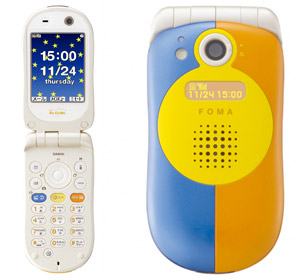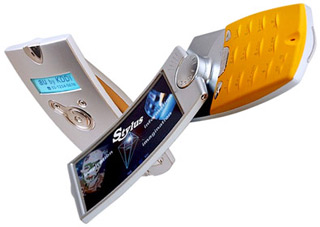 NTT DoCoMo have just announced a new ‘child-friendly’ 3G mobile phone, the FOMA SA800i made by Sanyo. The SA800i’s functions and compatible services are designed to help keep children safe, according to company PR. It is configured for easy use by children, and its rounded shape resembles a cocoon to emphasize the phone’s child-oriented security features. The handset has an alarm of about 100 decibels that children can quickly switch on in the case of an emergency and parents signed up for the new “imadoco search” location service can set their phones to automatically receive email announcing the child’s physical location, and the emails will continue at regular intervals.
NTT DoCoMo have just announced a new ‘child-friendly’ 3G mobile phone, the FOMA SA800i made by Sanyo. The SA800i’s functions and compatible services are designed to help keep children safe, according to company PR. It is configured for easy use by children, and its rounded shape resembles a cocoon to emphasize the phone’s child-oriented security features. The handset has an alarm of about 100 decibels that children can quickly switch on in the case of an emergency and parents signed up for the new “imadoco search” location service can set their phones to automatically receive email announcing the child’s physical location, and the emails will continue at regular intervals.
If the child activates the alarm, the handset will call up to three registered numbers with a voice message alert at regular intervals until all registered numbers pick up, or until a password is entered into the child’s handset. In addition, DoCoMo has established the Kids’ Advisory Board of people with expertise in children’s issues, who will advise the company on the development of products and services beneficial to children. The parents who are signed up for imadoco search can also set their phones to receive an automatic email of the child’s location when the child’s handset is turned off. Moreover, even after the child’s handset is switched off, it is possible to receive e-mails of the phone’s whereabouts in 15-, 30- or 60-minute intervals. The emails continue until a password is entered into either the parent’s or child’s handset.


 Today’s WWJ video is full of gorgeous, uhm.. mobiles. This fall, DoCoMo introduced their new 701i models using… models. The
Today’s WWJ video is full of gorgeous, uhm.. mobiles. This fall, DoCoMo introduced their new 701i models using… models. The  The latest models from KDDI’s
The latest models from KDDI’s  NTT DoCoMo have just announced a new ‘child-friendly’ 3G mobile phone, the FOMA SA800i made by Sanyo. The SA800i’s functions and compatible services are designed to help keep children safe, according to company PR. It is configured for easy use by children, and its rounded shape resembles a cocoon to emphasize the phone’s child-oriented security features. The handset has an alarm of about 100 decibels that children can quickly switch on in the case of an emergency and parents signed up for the new “
NTT DoCoMo have just announced a new ‘child-friendly’ 3G mobile phone, the FOMA SA800i made by Sanyo. The SA800i’s functions and compatible services are designed to help keep children safe, according to company PR. It is configured for easy use by children, and its rounded shape resembles a cocoon to emphasize the phone’s child-oriented security features. The handset has an alarm of about 100 decibels that children can quickly switch on in the case of an emergency and parents signed up for the new “